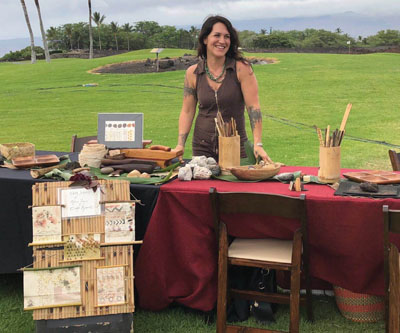Myths and Legends of Mauna Kea
By Leilehua Yuen
In English, when we speak of literature, we generally classify works as fiction or non-fiction—made up or true. How does one define true? Sometimes, a story that does not adhere to quantifiable data, yet draws on emotion and archetype conveys more truth than a recitation of data can. Often, we call such stories myths.
The late mythologist Joseph Campbell wrote “…there are two totally different orders of mythology. There is the mythology that relates you to your nature and to the natural world, of which you’re a part. And there is the mythology that is strictly sociological, linking you to a particular society.”
Myths are part of a society’s common attempt to explain humanity’s role in the universe. Campbell also wrote, “Myth makes a connection between our waking consciousness and the mystery of the universe. It gives us a map or a picture of the universe and allows us to see ourselves in relationship to nature.”
Legends serve a different purpose. Legends are told as history and often emphasize characteristics of individuals they portray in order to teach moral legends.
Both myths and legends—especially legends—may be based on actual people and events.
Mo‘olelo, generally translated to English as “story,” usually is told with a purpose, to teach, explain, or record something. Myth is often mo‘olelo.
Ka‘ao, a less well-known term, is a bit more narrow in concept. Often told for entertainment, ka‘ao may be more fanciful and romantic than mo‘olelo. Legends tend to be constructed more like ka‘ao, though they often are used like mo‘olelo.
Mo‘olelo, ka‘ao, myth, and legend enfold Mauna Kea like the clouds that wreath the great mountain. Their words, like raindrops, bring life to the landscape of the mind. Some stories, like the mists, conceal then reveal what has been before us all along.

Sometimes they are told simply, other times they are told in all their depth and complexity. There are many stories, for each migration brought its own traditions and understandings. The stories evolved, for each generation built on the traditions and history of its forebears. Each ‘ohana tells the stories in its own way to bring the understanding of the past to the future.
The Hawaiian language newspapers, many of which are now available online through resources such as nupepa.org and the University of Hawai‘i’s libweb.hawaii.edu Hawaiian newspaper collection are a fascinating way for people to find mo‘olelo and ka‘ao related to their own family stories.
In the July 20, 1836 edition of Ke Kumu Hawaii, we find that the “poe kahiko, olelo lakou ua hanau maoli mai no keia pae aina, na Wakea laua o Papa, e like me ka hanau keiki ana.” The people of ancient times said that the birth of the Hawaiian archipelago was from the joining of Wākea and Papa, the same way children are born.
In the January 31, 1912 edition of Ke Au Hou, John H. Wise discusses a genealogical chant for Kauikeaouli. One line says, “Hanau ka mauna, he keiki mauna na Wakea.” The mountain is born, a child from Wākea. The beautiful poetry references the legendary birth of the mountain from the mating of Wākea and Papa.
The Birth of the Islands
Long, long ago, when the world was new, Wākea, the Sky Father, looked down and saw the beauty of Papa, the Earth Mother. Her ocean garment flowed about her body, moving gracefully, and the bioluminescence glimmered like the stars above in Wākea’s kīhei of night. From this love was born mountains which rose high above Papa’s waves, touching the face of their father. He placed beautiful lei of clouds on their heads, and Papa placed beautiful lei of sea foam on their necks.
Over time, other children were born to Papa and Wākea. Coral children, fish children, and seaweed children. Grass children, tree children, and bird children were born. Four legged children that crept and ran across the ground were born. At last, two legged children were born to live on the great sea mountains and tell their stories.
Deities of Mauna Kea
Most famous of the deities of Mauna Kea probably is Poli‘ahu, the beautiful snow goddess who makes the summit her home, and she has sisters who are equally important.
In the March 27, 1862 edition of Ka Hoku o ka Pakipika, Kahauanu wrote about a trip up Mauna Kea. “…a hiki ma kahi i kapa ia o Poliahu, nui loa ke anu, a manoanoa no hoi ke ku ana o ka hau malaila, aole o kana mai. Ua noho iki no malaila, e kilohi ana ma o, a maanei o ka mauna, a e nana aku ana ia Maui. . . e nana mai ana ia Hilo nei, i ka waiho kahela ae i ka malie…ma e imi i kela kiowai i kapa ia o Kahoupokane, ma kahi kokoke no i Poliahu, kahi hoi a Lilinoe i noho ai, kela wahine noho i ke anu o Maunakea, a lawa pono ka makemake.”
“We came to the place called Poli‘ahu. It was very cold, the ice was numbing. It was incomparably cold. We rested a bit there, gazed here and there at the mountain, we were looking at Maui…we were looking at Hilo that was spread out before us in the calm…then sought that pool of water called Kahoupokane, close by Poli‘ahu, the place where Lilinoe lived, that woman who dwells in the chill of Maunakea, sufficient in their preference.”
In the February 22, 1862 Ka Nupepa Kuokoa, a mele inoa (name chant) for Keanolani (one of Princess Ruth Ke‘elikōlaniʻs names), mentions Lilinoe, younger sister to Poli‘ahu. “Kokohi mai o Lilinoe, ka wahine noho i Poliahu.” The fine mists of Lilinoe darken, the woman who dwells with Poli‘ahu.
These beings embody the forces of the mountain itself. The battle between Pele, goddess of the volcano, and Poli‘ahu created the dense basalt of the mountain, as the magma was cooled by glaciers.
As beautiful, nurturing, unforgiving, and deadly as nature, the stories encode lessons and warnings. They show that Hawaiian people had a deep understanding of the geological, meteorological, and hydrological forces that shaped these islands and their ecology, though the ka‘ao and mo‘olelo often describe them in terms of romance. The most famous of these stories, the courtship of Aiwohikupua, is part of the longer mo‘olelo, The Romance of La‘ieikawai.
Aiwohikupua
This Lothario of Kaua‘i pursued the Puna chiefess, La‘ieikawai. She rejected him. On his way home, he followed the Hāmākua coastline. Passing Laupāhoehoe, he saw a beautiful chiefess surfing and proposed marriage to her. She exchanged her snowy kīhei for his feathered cloak before he set sail for home to prepare for the wedding.
On his way home to Kaua‘i, he stopped at Hāna, Maui, and met Hinaikamalama. He gambled with her, and lost. As he, himself, was the forfeit, he had to agree to marry her. However, he delayed the wedding on the excuse that he had to make a journey. The journey was to fetch Poli‘ahu.
When Hinaikamalama learned of the wedding, she traveled to Kaua‘i and joined the wedding celebrations. At a game of kilu she demanded her right to speak, and told how Aiwohikupua had cheated her. Poli‘ahu, infuriated, returned to Mauna Kea. Aiwohikupua agreed to fulfill his vows to Hinaikamalama, and took her to the wedding house.
Each time they took each other in their arms, Poli‘ahu would cover them with either the icy cold of her snows or the searing heat of the summit sun. At last Hinaikamalama could not take it any longer and returned to Maui. Because of his infidelity, Aiwohikupua was left alone.
Perhaps the cold and heat flowing from Mauna Kea and then receding encode memories of periods of glaciation and warming in the Pacific Basin?
Less famous today, the story of Kahānaiakeakua teaches an important lesson about the Wao Akua, the high alpine regions of Mauna Kea reserved for the gods. Though the language of ancient Hawai‘i had no word for “hypothermia,” it was a recognized physiological effect. Kahānaiakeakua was lucky. In other stories, the young man is found in the spring, after Poli‘ahu removes her kapa of snow.
Kahanaiakeakua
Before humans learned to be more than just another kind of animal, they had no chiefs. The first chief was the son of Kū and Hina, and was reared by Kāne and Kanaloa, and given the name Kahānaiakeakua. He was married to his sister, Paliula. One day while hunting on the slopes of Mauna Kea he became lost in the mist. Every which way he turned, he felt he was traveling farther and farther upslope. The ferns and small creeping plants seemed to cover his path and prevent his return to lower ground.
Finally he broke out of the forest onto stony ground, where he was met by a beautiful woman. He was instantly overcome with desire for her. Though he had been cold as he walked, he now felt warm. He felt lightheaded, and strange in his stomach. His vision became black around the edges, and all he could see was the white and glowing beautiful woman ahead of him.
When she embraced him, his body felt numb, and when they began to honi (kiss), it was as if she inhaled all of his breath, and he became faint. Losing all sense, he simply followed her about, desiring only to be near her. At last she tired of him, and returned him to the forest from which he finally made his way to the home of his parents, who nurtured him back to health. He became a very knowledgeable kahuna in sorcery and sacrifice. Paliula finally forgave him for his infidelity and they were reunited.
Kahoupokane
She is the goddess of Hualālai, and a master kapa maker. When the heavy rains come from the mountains, she is throwing water on her kapa as she beats it. When thunder rolls, that is the sound of beating the kapa. The flash of lightening is when she flips the bright new kapa over to beat the other side. The morning after a storm, her kapa can be seen drying on the mountains, shining in the sunlight. On a sunny day, when there is thunder and a fine misty rain with no clouds, you know she is pounding their summer garments.
Kalauakolea
A sister of Poli‘ahu, she is a musician and chanter, and sometimes sings and plays with Lilinoe.
Kukahau‘ula
Kū, as he appears in the red of the rising sun. He pursued Poli‘ahu and is identified with the highest peak of Mauna Kea. The name also is identified with a chief of Waimea, Kohala, who married a Ka‘ū woman named Lilinoe. When his people did not like her, the couple retired to Mauna Kea where they lived in a cave. The bodies were seen and identified by Kauikeaouli, Kamehameha III. After that discovery, the bodies were hidden away by their family’s last surviving retainer, Pohe‘epali.
Lilinoe
Goddess of fine mist. She also is the goddess of Haleakalā, dead fires, and of desolation. She dresses Poli‘ahu’s hair so that it is soft and fine, and floats like a cloud about her. She was married to Nana-nu‘u, the mortal who survived the great flood, and made his home in a cave high on the slopes of Mauna Kea. The name also is identified with a woman of Ka‘ū who married a Waimea, Kohala chief named Kūkahau‘ula.
Mo‘oinanea
This great ancestress lizard or dragon is the progenitress of a vast clan of fresh-water-dwelling beings. She sometimes participates in arranging marriages for chiefly children, and in the story told by Ahu‘ena Tayor, was the intermediary for the courtship of Kūkahau‘ula and Poli‘ahu.
Poli‘ahu
The icy goddess of Mauna Kea was not easy for swains to approach.
Poli‘ahu, whose name means “cloaked bosom,” or “temple bosom,” is a legendary daughter of Wākea who dwells at the summit of Mauna Kea. As the chill snow goddess, she is the antithesis of her fiery archrival, Pele.
It is Poli‘ahu who spreads her beautiful white kapa across the summit of Mauna Kea in the winter, and adorns the mountain with her pink and gold cloak in the summer.
She is the goddess of Mauna o Wākea (today often called Mauna Kea), snow, ice, and cold. The summit of Mauna Loa also is hers, though she occasionally still has arguments with Pele regarding that. She is the eldest daughter of Kāne. Her younger sisters are her ladies in waiting. Many men have pursued her, yet she always ends up alone. Perhaps this is a warning that the summit is not a place where humans are meant to remain.
Waiau (Waiaie)
She is the guardian of the lake which bears her name. She bathes Poli‘ahu, and refreshes her drinking gourd with sweet water that she can fetch by using her bird form to fly from
place to place.
Myth: A usually traditional story of ostensibly historical events that serves to unfold part of the world view of a people or explain a practice, belief, or natural phenomenon. (merriam-webster.com)
Legend: A story coming down from the past; especially: one popularly regarded as historical although not verifiable. (merriam-webster.com)
Mo‘olelo: Story, tale, myth, history, tradition, literature, legend, journal, log, yarn, fable, essay, chronicle, record, article; minutes, as of a meeting. (From mo‘o ‘ōlelo, succession of talk; all stories were oral, not written.) (wehewehe.org)
Ka‘ao: Legend, tale, novel, romance, usually fanciful; fiction; tell a fanciful tale. ho‘o.ka‘ao To tell tales; story telling. (wehewehe.org) ❖
Contact writer/photographer Leilehua Yuen
Bibliography
Beckwith, Martha Warren; The Hawaiian Romance of Laieikawai
Campbell, Joseph; The Power of Myth 22-23; Reflections 56
Ke Au Hou; Vol 3 # 4; 31 January 1912
Ke Kumu Hawaii; 20 July 1836
Westervelt, William Drake; Hawaiian Legends of Ghosts and Ghost-Gods
Mauna a Wakea
Ulukau Collection


